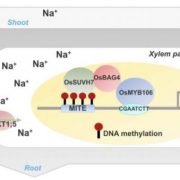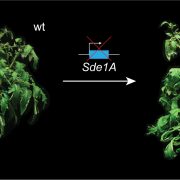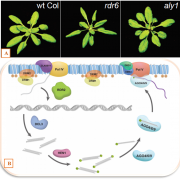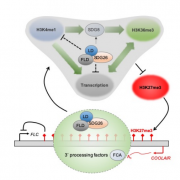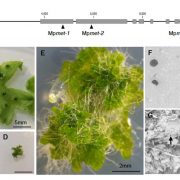Arabidopsis long non-coding RNAs: an orchestrated hubbub
Kornienko et al. discover that Arabidopsis genome is full of long-non-coding RNAs that show their expression only in specific tissues and plants from different geographic origins because of differences in epigenetic silencing of these genes.
Plant Cell – https://doi.org/10.1093/plcell/koad233
By Aleksandra E. Kornienko
Background: Only a small fraction of the genome encodes proteins. We were interested in a special type of gene called long non-coding RNAs (lncRNAs): They are transcribed from the genome but do not encode proteins. LncRNAs can regulate genes or organize cell structures but are largely not studied, and we know very little about lncRNAs as a gene class. For example, we know lncRNAs evolve very quickly and are different between species, but we do not know well how they differ within one species and what is responsible for this difference.
 Question: We wanted to know how many lncRNAs are present in the model plant Arabidopsis (Arabidopsis thaliana), how they differ in plants from different regions, and whether the recently reported widespread epigenetic variation in Arabidopsis underlies this difference. We used many transcriptome and epigenetic sequencing datasets to answer these questions.
Question: We wanted to know how many lncRNAs are present in the model plant Arabidopsis (Arabidopsis thaliana), how they differ in plants from different regions, and whether the recently reported widespread epigenetic variation in Arabidopsis underlies this difference. We used many transcriptome and epigenetic sequencing datasets to answer these questions.
Findings: We discovered that the Arabidopsis genome is full of lncRNAs, although most are epigenetically inactivated. Plants from different regions have different sets of active lncRNAs, and epigenetic differences are responsible for much of this difference. Intergenic lncRNAs were particularly variable in their expression levels and contained pieces of transposons, selfish genes that can move and propagate in the genome. Cells fight the spread of transposons with elaborate systems inactivating them and preventing them from harming the genome. We determined that these transposon pieces made lncRNAs look like transposons and become inactivated by the same system.
Next steps: It is unclear what underlies the epigenetic variation causing lncRNA variation; is it a difference in sequence, or the absence of the whole lncRNA gene from the genomes of Arabidopsis from certain regions? What contributes the most? Another direction is to understand the nature and origin of transposon pieces inside lncRNAs.
Reference:
Aleksandra E. Kornienko, Viktoria Nizhynska, Almudena Molla Morales, Rahul Pisupati, Magnus Nordborg (2023) Population-level annotation of lncRNAs in Arabidopsis reveals extensive expression variation associated with transposable element-like silencing. https://doi.org/10.1093/plcell/koad233



